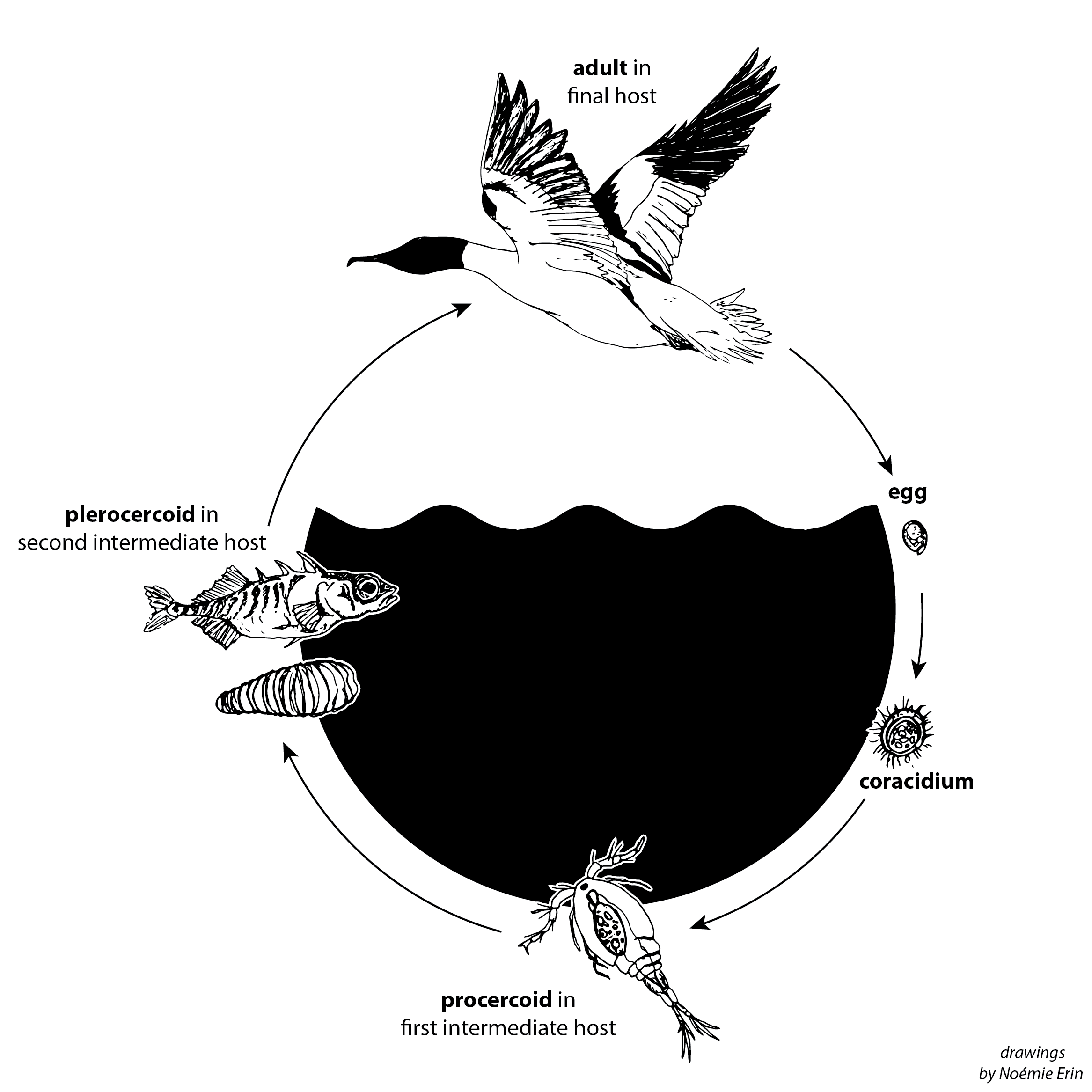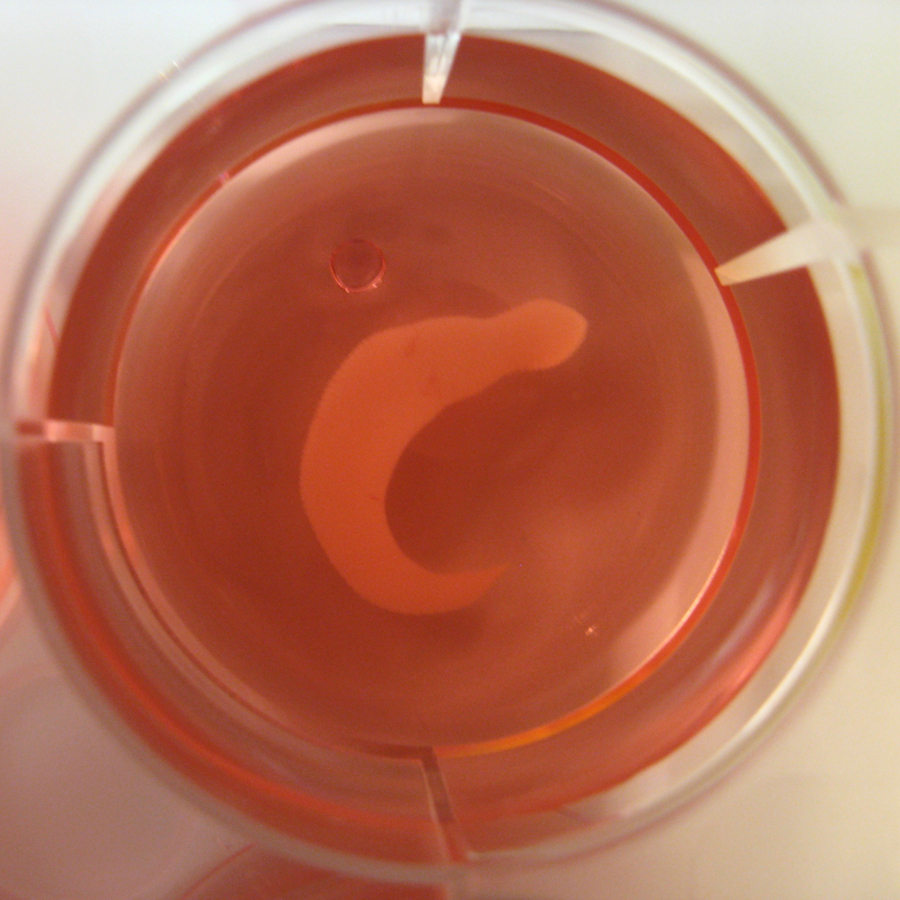Research
an overview of my research

RESEARCH INTERESTS:
I am an evolutionary biologist studying parasites in the context of evolutionary ecology. I am interested in parasites as a selective force of adaptation for both hosts and parasites themselves. My work cover the following research themes:
Host-Parasite Coevolution, Within-Host Parasite Interaction, Parasite-Mediated Selection, Ecological Adaptation, Ecological Speciation, Local adaptation
RESEARCH TOOLS:
My research is based on field survey, experimental infections and selection experiments. I have mainly used the three-spined stickleback (Gasterosteus aculeatus) and its specific tapeworm Schistocephalus solidus as a host-parasite model system.
Skills: parasite screening, molecular genetics (PCR, genotyping, cloning, sequencing), gene expression (qPCR), population genetics.

SCHISTOCEPHALUS SOLIDUS LIFE CYCLE
Schistocephalus solidus eggs are dispersed in freshwater in the faeces of fish-eating birds (final host) infected with mature S. solidus. Free-swimming coracidium larvae hatch from the eggs and are eaten by cyclopoid copepods (first intermediate host) in which they develop into the procercoid larval stage. Three-spined stickleback (second intermediate host) gets infected when preying on infected copepods. The plerocercoid stage develops in the fish body cavity and completes the cycle when the fish is eaten by the final bird host. S. solidus is a simultaneous hermaphrodite and reproduces sexually (by selfing or cross-fertilization) in the bird digestive tract.
(illustration credits: Noémie Erin)



RESEARCH PROJECTS:
Parasite strain-specific selection & MHC
Why it’s interesting: Genes of the major histocompatibility complex (MHC) are the most polymorphic genes in vertebrates and serve as a model to understand the maintenance of polymorphism in natural populations. MHC receptors are involved in the antigen recognition and activation of the adapted immune response during infection, and therefore parasite-mediated selection is a key driver of MHC genetic diversity. Different parasite species are able to select for different resistance MHC alleles§, hence promoting MHC polymorphism in natural populations exposed to complex parasite communities. But in theory, host-parasite interactions with only one parasite species, but different genotypes/strains, should suffice to ensure the maintenance of some MHC polymorphism.
What we did: In replicated mesocosms, we selected experimental three-spine stickleback populations for resistance against two strains of S. solidus. After natural reproduction, we exposed the second generation of hosts to both parasites strains to measure selection for specific resistance.
What we found: The analysis is in progress… but we predict that frequency shifts of different MHC alleles due to strain-specific resistance alleles.
Co-authors:
Joshka Kaufmann, Christophe Eizaguirre, Martin Kalbe, Tobias L. Lenz
Associated publications:
Erin & Kaufmann et al. (in prep)
§Eizaguirre et al. 2012 Nature Communications doi:10.1038/ncomms1632



Relaxed parasite-mediated selection & limit to gene flow
Why it’s interesting: Under certain conditions, adaption to divergent ecological pressures can limit gene flow between populations and lead to reproductive isolation and ecological speciation. What happen when individuals are naturally transfected from a low to a high parasite selective pressure?
What we did: Over four years of field survey, I measured the macroparasite community and the population genetics of two three-spined stickleback (Gasterosteus aculeatus) populations to assess the influence of divergent parasite-mediated selection on unilateral gene flow between an upstream river and a downstream lake in Western Norway.
What we found: I described the first reported macroparasite-free stickleback population and demonstrated its reduced resistance to parasites using experimental infection with the cestode Schistocephalus solidus and the trematode Diplostomum pseudospathaceum. This relaxed selection might explain why migrant river fish fail to invade the downstream parasite-rich environment of the lake population.
Co-authors:
Tina Henrich, Irene E. Samonte, Per J. Jakobsen, Martin Kalbe
Associated publications:
Erin et al. (in prep)



Resist globally, infect locally: a trans-continental test of adaptation by stickleback
This project is a transcontinental collaboration with our colleagues at the Bolnick Lab (University of Texas, Austin).
Why it’s interesting: Parasites have a highly heterogeneous spatial distribution that depends on both ecological (host-parasite encounter rates) and evolutionary (host susceptibility shaped through coevolutionary dynamics) determinants. What is the relative importance of exposure and resistance on the prevalence of the parasite S. solidus in three-spine stickleback populations: does low infection rates imply low exposure rates or high resistance?
What we did: We used reciprocal experimental infection of Canadian and European three-spined stickleback with S. solidus to obtain local (coevolved) and transcontinental (not coevolved) combinations.
What we found: 1) The infection risk shapes the convergent evolution of resistance to S. solidus, which is recently derived through colonization of freshwater habitats. In fact, there is a negative correlation between host susceptibility and natural infection rates: while S. solidus infections are rare in the highly susceptible marine population, they are commonly found in more resistant lake sticklebacks. 2) We found local adaptation at the scale of the local as more infections occurred in same-continent host-parasite combinations. Lake sticklebacks have evolved general resistance to S. solidus (hosts resist globally), while local S. solidus strains have counter-adapted to infect local sympatric hosts (parasites infect locally).
Co-authors:
Jesse N. Weber, Martin Kalbe, Kum Chuan Shim, Natalie C. Steinel, Lei Ma, Daniel I. Bolnick
Associated publications:
Weber et al. 2017 The American Naturalist doi:10.1086/689597



Host-parasite optimal local adaptation
Why it’s interesting: S. solidus realizes its entire growth in its stickleback host iduring several weeks or months before being trophically transmitted to the final bird host. This implies a fine-tuned molecular cross-talk between S. solidus and the host immune system to evade and manipulate the fish immune response. But the exact underlying molecular mechanism(s) of host resistance/parasite virulence and how these adaptive strategies may vary between different populations/genotypes remains unknown.
What we did: Two host-parasite population pairs experiencing different levels of natural parasite prevalence were used in a full reciprocal exposure experiment. We obtained four combinations of sticklebacks infected with sympatric (coevolved) and allopatric (non-coevolved) S. solidus and compared, across three time points, the parasite growth and the differential expressions of eight immune genes (RT-qPCR) involved in mounting the innate and adaptive response against parasites in two host immunologically relevant organs (head-kidney and spleen).
What we found: While strong differences in host exploitation, as shown by differences in relative weight reached by the parasites (parasite index PI), were found in allopatric combinations, both sympatric host-parasite pairs seemed to have reach the same resistance/virulence optimum through different co-evolutionary routes (highly resistant host/highly virulent parasite and vice versa). Gene expression patterns of antigen recognition, Th1 and Th2 responses showed signs of potential immune manipulation in coevolved combinations when parasite reached infectivity.
Co-authors:
Irene E. Samonte, Per J. Jakobsen, Martin Kalbe
Associated publications:
Kalbe et al. 2016 Parasites & Vectors doi:10.1186/s13071-016-1419-3
Benesh & Kalbe 2016 Journal of Animal Ecology doi:10.1111/1365-2656.12527
Scharsack et al. 2016 Zoology doi:10.1016/j.zool.2016.05.008
Franke et al. 2014 Fish & Shellfish Immunology doi:10.1016/j.fsi.2013.10.019



Within-host parasite competition alters virulence
Why it’s interesting: In nature, multiple infections with different strains or species of parasites are the rule rather than the exception. Studying parasite-parasite interactions within the host is vital to truly understand host-parasite interactions and co-evolution.
What we did: Using two S. solidus strains differing in virulence to infect fish host, three-spined stickleback, we measured the expression of virulence in homologous (double infection with same strain/virulence parasites) and heterologous (double infection with two different strain/virulence parasites) combinations.
What we found: There is a genetic and plastic component to virulence as the level of expressed virulence was determined by both the parasite’s strain (low vs. high virulence) and the strain of the conspecific competitor. Those results may be explained by the production of two types of goods during host exploitation: common goods (sharable with any competitor) and strain-specific goods (sharable only within strain).
Co-authors:
Tina Henrich, Luke Phelps, Martin Kalbe
Associated publications:
Henrich & Erin et al. (in prep)



Parasites & maintenance of diversity in feral pigeons
Why it’s interesting: Unfairly disliked by city-dwellers, feral pigeons (Columba livia) are an integrative part of the modern urban fauna. Perceived as disease-spreading ‘flying rats’ by the general public, there are actually only a handful of pigeon-borne pathogens that are transmissible to humans. They are for instance a reservoir for the bacteria Chlamydia psittaci (Chlamydiaceae), the agent of a respiratory infection, the human psittacosis. While only a few cases are reported each year, the infection is potentially lethal without antibiotic treatment and it is important to understand the factors influencing the epidemiology and transmission risk of Chlamydia in the urban environment.
What we did: We studied the link between host melanin-based coloration phenotype, which in avian species is controlled by a pleotropic gene system involved in both coloration and immunity, and Chlamydia prevalence in different urban habitats (pigeon houses vs. streets) by sampling pigeons throughout Paris.
What we found: There is a difference in Chlamydia excretion between different pigeon morphs, as darker pigeon excreted more Chlamydia than paler ones. This might indicates a higher tolerance to disease and a higher risk of transmission in darker pigeon morphs.
Co-authors:
Adrien Frantz, Lisa Jacquin, Philippe Lenouvel, Claire Bertin, Fabien Vorimore, Karine Laroucau, Julien Gasparini
Associated publications:
Jacquin et al. 2013 Oecologia doi:10.1007/s00442-013-2663-2
Gasparini et al. 2011 Environmental Microbiology doi:10.1111/j.1462-2920.2011.02575.x
